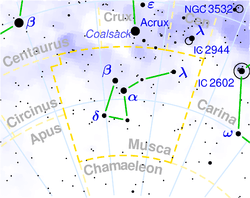Delta Muscae
Delta Muscae, Latinized from δ Muscae, often catalogued as HD 112985, is a spectroscopic binary star system and the closest to the Earth in the southern hemisphere constellation of Musca (the Fly) at a distance of approximately 27.8 parsecs (91.0 light years). The main star is classified as a giant star with an orange tint. It is one of the stars given a Bayer designation by astronomer Johann Bayer. It was recorded in Bayer's 1603 publication Uranometria. In addition it is one of the main stars used in the visual formation of the Musca constellation.
 Delta Muscae (labeled δ) is the bottom left star in Musca. | |
| Observation data Epoch J2000 Equinox J2000 | |
|---|---|
| Constellation | Musca |
| Right ascension | 13h 02m 16.26474s[1] |
| Declination | −71° 32′ 55.8752″[1] |
| Apparent magnitude (V) | +3.61[2] |
| Characteristics | |
| Spectral type | K2III[3] |
| U−B color index | +1.26[2] |
| B−V color index | +1.18[2] |
| Astrometry | |
| Radial velocity (Rv) | 36.5 ± 0.9[4] km/s |
| Proper motion (μ) | RA: 264.17[1] mas/yr Dec.: −22.75[1] mas/yr |
| Parallax (π) | 35.88 ± 0.44[1] mas |
| Distance | 91 ± 1 ly (27.9 ± 0.3 pc) |
| Absolute magnitude (MV) | +1.38[5] |
| Orbit[6] | |
| Period (P) | 422.0266 ± 5.3908 d |
| Semi-major axis (a) | 11.67 ± 1.02 mas |
| Eccentricity (e) | 0.4918 ± 0.1241 |
| Inclination (i) | 120.07 ± 6.02° |
| Longitude of the node (Ω) | 59.27 ± 5.29° |
| Periastron epoch (T) | JD 2447947.6680 ± 27.5934 |
| Argument of periastron (ω) (secondary) | 316.39 ± 26.13° |
| Details | |
| Luminosity | 42[5] L☉ |
| Other designations | |
| Database references | |
| SIMBAD | data |
Distance and visibility
Based on research done by the European Space Agency for the Hipparcos Star Catalogue, Delta Muscae exhibits a parallax of 35.91 milliarcseconds.[7] With this data, it can be calculated that Delta Muscae is situated at a distance of 27.8 parsecs, or 91.0 light years, from the sun.
Even though Delta Muscae is the closest star to Earth in the Musca constellation, nearly 3800 stars are closer in proximity to the Earth as stated by the Gliese Catalogue of Nearby Stars, which includes stars within twenty-five parsecs of the Sun.[8]
Delta Muscae is a star of the third magnitude (or 3.61(v) to be exact) when viewed from the Earth, and is visible to the naked eye in regions that lack dense light pollution.[7]
Stellar and system characteristics
Delta Muscae has a listed spectral type of K2III.[9] The K2 portion of this designation specifies that Delta Muscae A is a class K2 star, meaning the light it emits is orange in color. The main star burns at a temperature cooler than the Sun, which is a G2 star. The second part of the classification, III, specifies that Delta Muscae is a giant star which has already left the main sequence of star life like the Sun.
References
- van Leeuwen, F.; et al. (2007). "Validation of the new Hipparcos reduction". Astronomy and Astrophysics. 474 (2): 653–664. arXiv:0708.1752. Bibcode:2007A&A...474..653V. doi:10.1051/0004-6361:20078357.
- Cousins, A. W. J.; Stoy, R. H. (1962). "Photoelectric magnitudes and colours of Southern stars". Royal Observatory Bulletin. SIMBAD. 64 (64). Bibcode:1962RGOB...64..103C.
- Gray, R. O.; Corbally, C. J.; Garrison, R. F.; McFadden, M. T.; Bubar, E. J.; McGahee, C. E.; O'Donoghue, A. A.; Knox, E. R. (2006). "Contributions to the Nearby Stars (NStars) Project: Spectroscopy of Stars Earlier than M0 within 40 pc--The Southern Sample". The Astronomical Journal. 132: 161. arXiv:astro-ph/0603770. Bibcode:2006AJ....132..161G. doi:10.1086/504637.
- Evans, D. S. (2006). "The Revision of the General Catalogue of Radial Velocities". Determination of Radial Velocities and their Applications. 30: 57. Bibcode:1967IAUS...30...57E.
- Anderson, E.; Francis, Ch. (2012), "XHIP: An extended hipparcos compilation", Astronomy Letters, 38 (5): 331, arXiv:1108.4971, Bibcode:2012AstL...38..331A, doi:10.1134/S1063773712050015.
- "Sixth Catalog of Orbits of Visual Binary Stars". United States Naval Observatory.
- "HIP 63613". The Hipparcos and Tycho Catalogues. ESA. 1997. Retrieved 16 December 2008.
- "Gliese Catalogue of Nearby Stars". Preliminary Version of the Third Catalogue of Nearby Stars. Gliese et all. 1991. Retrieved 16 December 2008.
- "* del Mus". SIMBAD. Centre de données astronomiques de Strasbourg. Retrieved 16 December 2008.